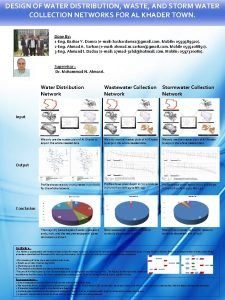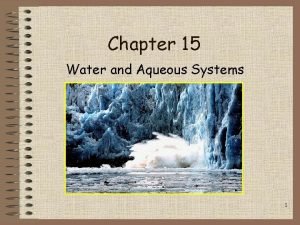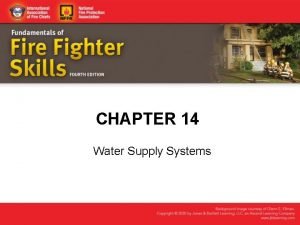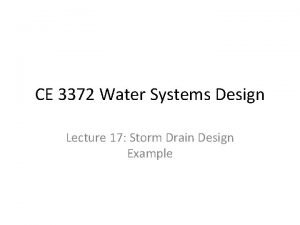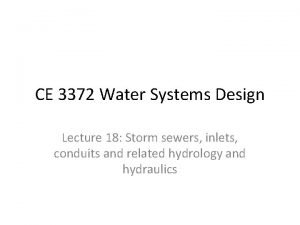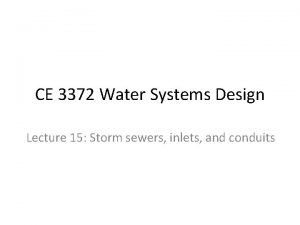CE 3372 WATER SYSTEMS DESIGN LESSON 19 STORM
















- Slides: 16

CE 3372 WATER SYSTEMS DESIGN LESSON 19: STORM SEWER DESIGN EXAMPLE (TANGLEWILDE STORM SEWER)

DESIGN STORM SEWER FOR TANGLEWILDE • Method: Rational Equation Design Method to make initial design for subsequent hydraulics analysis • Identical study area as ES-13

PREPARATION STEPS • Apply (make) topographic map principles to identify drainage pattern(s) • Identify the individual drainage areas based on the topographic map and sewer system layout. • Determine the area of each contributing area, in acres. (ENGAUGE, PLANIMETER, etc) • Determine the rational runoff coefficient for each area (TABLE LOOKUP)

PREPARATION STEPS • Determine inlet time for surface portion of drainage system. • Determine rainfall intensity equation for Harris County.

ANALYSIS STEPS • Apply the intensity equation to the various surface drainage areas, and the accumulating area to size the conduits. • Check invert elevations to fit into the useable vertical drop for the location • Size the inlets using appropriate inlet hydraulics equations.

TOPOGRAPHIC MAP • Locate the elevations and construct an XY coordinate system.

TOPOGRAPHIC MAP • Use the XY-coordinate system and build an XYZ input file for topographic rendering.

TOPOGRAPHIC MAP • Render a topographic map using appropriate tools • • • By-hand; Excel, R-script Quick. Grid, Surfer, etc. Arc GIS, q. GIS, etc. • Adjust settings to build an overlay

TOPOGRAPHIC MAP • Overlay the map – use known data locations (in XY) to reference the overlay to the sewer drawing

DETERMINE DRAINAGE AREAS • Identify the individual drainage areas using the topographic rendering and the project layout drawing. • We will assume that drainage from outside the project area is collected elsewhere • The figure to the right is intended as a guide to the method – the areas listed are not topographically justified; that is left as an exercise!

DETERMINE PIPE DISTANCES • Identify the pipes to be sized in the drainage network • Measure the pipe lengths

TABULATE PREPARATORY RESULTS

DETERMINE INLET TIMES • Declare a travel distance on a drainage area to an inlet • Determine slope along that path • Apply a Tc estimation method • Repeat for each inlet

DEVELOP AN INTENSITY EQUATION •

DEVELOP AN INTENSITY EQUATION •

ANALYSIS • Apply the intensity equation as needed
 Rfc 3372
Rfc 3372 Water and water and water water
Water and water and water water Storm water distribution design
Storm water distribution design Difference between dwf and wwf
Difference between dwf and wwf A great white light crashed through the
A great white light crashed through the Design storm in hydrology
Design storm in hydrology Decision support systems and intelligent systems
Decision support systems and intelligent systems Engineering elegant systems: theory of systems engineering
Engineering elegant systems: theory of systems engineering Embedded systems vs cyber physical systems
Embedded systems vs cyber physical systems Engineering elegant systems: theory of systems engineering
Engineering elegant systems: theory of systems engineering Water systems grade 8
Water systems grade 8 Wells water systems recently reported
Wells water systems recently reported Fresh and saltwater systems grade 8 test
Fresh and saltwater systems grade 8 test Water and aqueous systems worksheet answers
Water and aqueous systems worksheet answers Chapter 15 water and aqueous systems answer key
Chapter 15 water and aqueous systems answer key Chapter 14 water supply systems
Chapter 14 water supply systems Chapter 15 water and aqueous systems answer key
Chapter 15 water and aqueous systems answer key


